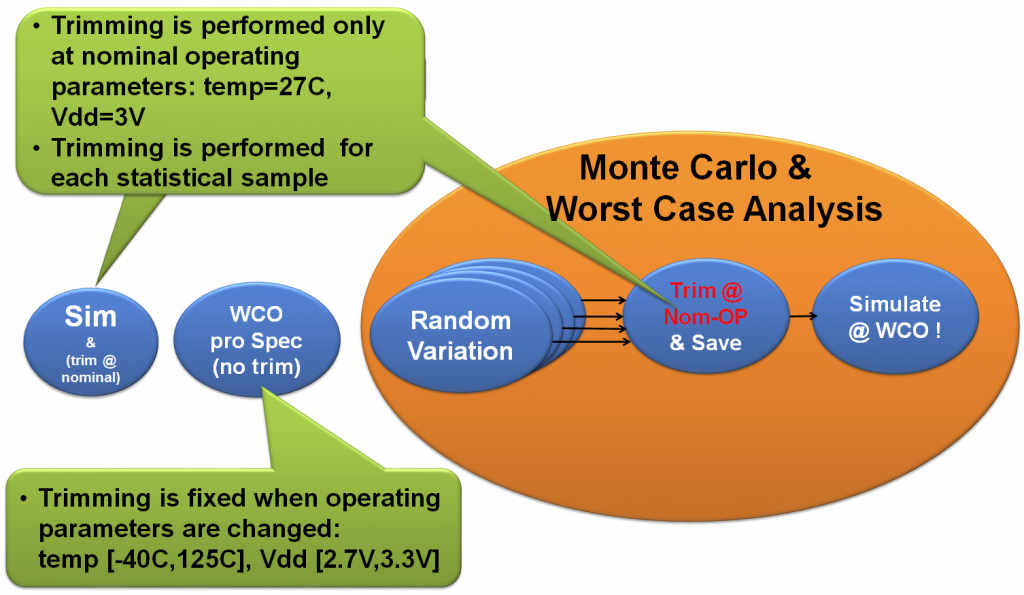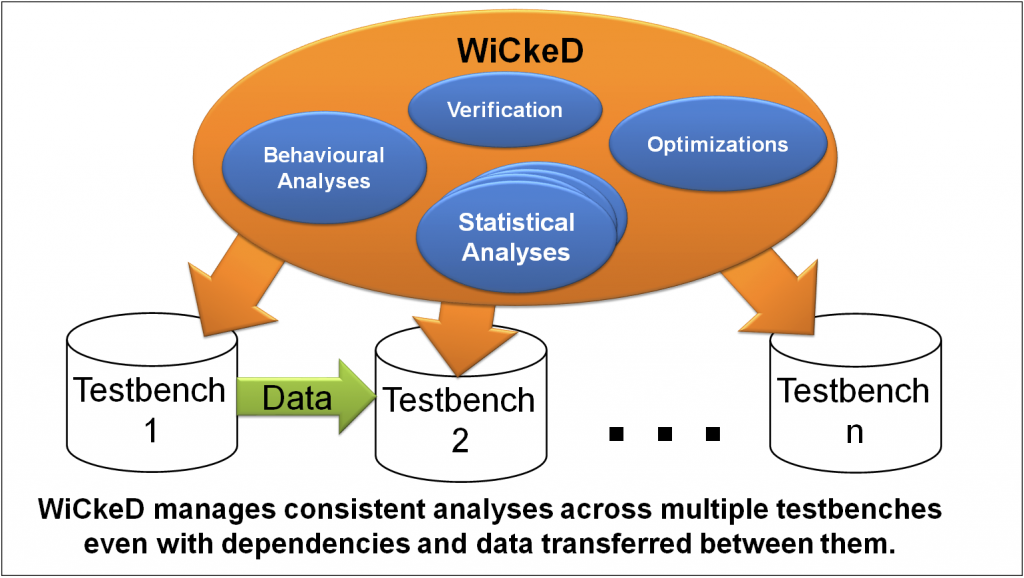
Dependent Simulations & Circuit Trimming
Introduction – Dependent Simulations & Circuit Trimming
Specific circuit analyses can not be setup in a single simulation run, but require the combination of multiple simulations. Sometimes these simulations sequentially depend on each other, i.e. when the result of a trimming calculation is required as input for a regular circuit simulation. In other cases it may be desired to combine the results of simulations from different simulators, sometimes even from diffent vendors into one analysis. The multi-testbench functionality in WiCkeD in combination with the scripting interface enables a very flexible way to combine the results from multiple simulators and simulations in a single analysis, even ensuring consistency in statistical analysis by assigning physically identical instances the consistent statistical sampling.
We refer to cascaded simulations when a simulation requires the result of another simulation as input. A typical example for this is when a circuit is being trimmed after production to compensate for statistical variations.
- Simulation flow for circuit trimming
- Trimming with different test benches
- Performance calculation with dependend multi-testbenches

Challenges for Circuit Trimming
Such trimming needs to be handled very carefully to reflect the real trimming scenario, which usually happens at nominal operating parameter conditions or at explicitly defined trimming conditions. When executing any analysis such as i.e. a Monte-Carlo analysis, it must be ensured that for each simulation sample a trimming step is executed where the trimming value is calculated while the operating parameters are set to the specific trimming conditions (in most cases nominal operating conditions), and then the desired simulation is executed with this calculated trim value and the operating parameters are set to the value contained in the main simulation call. In other words when doing a Monte-Carlo analysis at worst-case operating conditions this would be the pre-calculated worst-case operating condition for the selected specification.
Solution – Trimming and Dependend Simulation Flow handling with MunEDA WiCkeD
This is quite complex to handle manually and error prone. The cascaded simulations flow with WiCkeD ensures exactly this sequence, regardless what analysis it is applied with. WiCkeD’s multi-testbench functionality in conjunction with the scripting interface ensures this in an automated way, so once this is set up the designer can verify, analyse, optimize etc. without having to worry about this trimming and switching of operation conditions.
Specifically for Verification it is critical to use such automated flow to ensure correct verification results.
There are some special challenges to be taken into account using dependent simulations for circuit trimming:
- Process corners must be the same in all testbenches
- Operating parameters should be constant in one testbench while simulating the other testbenches with other values
- Corners should match
- Automatically corrects simulation of MC, high-sigma Analysis, Optimization
- Works with every circuit simulator and design framework
There are some special challenges to be taken into account using dependent simulations for circuit trimming:
- Process corners must be the same in all testbenches
- Operating parameters should be constant in one testbench while simulating the other testbenches with other values
- Corners should match
- Automatically corrects simulation of MC, high-sigma Analysis, Optimization
- Works with many circuit simulatosr and design frameworks
Process corners must be the same in all testbenches

MunEDA WiCkeD Multi-Testbench Environment for Circuit Trimming
WiCkeD generally provides flexibility with regard to simulator usage. Besides supporting dedicated interfaces to many common simulators from different vendors it is also possible to use generic interfaces to other simulators e.g. inhouse simulators of customers. An especially interesting aspect of the MunEDA WiCkeD MTB Multi-Testbench Functionality & Environment is the ability to combine different simulators in one analysis. This means it is possible to combine measurements extracted out of Simulator-1 simulation with measurements of Simulator-2 simulation to calculate specific performances.

This is critical for statistical analyses like Monte-Carlo where it has to be ensured that the identical samples are simulated in the two different simulators. This is not given in case the native Monte-Carlo functionality in each simulator is applied.
The Multi-Testbench functionality in MunEDA WiCkeD opens a wealth of possibilities for applications that are impossible inside the common single-vendor design frameworks. A simple example of such combinations is also the ability to execute the same simulation in different simulators and compare the results.
Typical Applications for Trimming
Long Simulations
One typical application for cascaded simulations happens if results of a long simulation run (i.e. transient) is required to calculate multiple results with short simulation runs (i.e. AC, DC). Leveraging WiCkeD’s Multi-Testbench functionality the cascaded simulations flow keeps track of such intermediate results, such that these pre-simulations are executed when needed, but avoids unnecessary resimulations when it has already been executed.
Cascaded Simulations
The Cascaded Simulations Flow is related to simulation setup and management and is applied in the background while any sort of verification, analysis, optimization or modelling is applied. Besides the tool to be applied and the WiCkeD Basic and Constraint Editor this Flow requires the scripting interface and the Multi-Testbench functionality.
Full Custom Low Power Designs
Typical applications for using WiCkeD for trimming your full custom low power design are Amplifiers, Transceiver, Data Converters (ADC, DAC), Oscillators, Mixer, Filter and more. The MunEDA WiCkeD tool set provides significant productivity gains over traditional design methods, and enables advanced circuit architectures with lower power consumption and higher performance. High performance, high speed, low power design, low noise requirements happen pre-dominantly in advanced technology nodes. For this reason designers can benefit from MunEDA’s circuit sizing tools to optimize performances, power, noise, area, yield and others.
WiCkeD has sufficient capacity to analyze and size large circuits with:
- >100 specifications and constraints handled simultaneously
- >200 design variables, >100.000 MOS
- Post-layout effects and parasitics supported
- Multiple test benches, goals, corners, considered
MunEDA WiCkeD – Technology Support
- WiCkeDTM & SPT Design Tool Suites
- Integrated into standard design environments
- For more information and support contact www.muneda.com

inPlay at SemiWiki 2023
“I see the MunEDA tools as basically another designer on my team. This is huge since we’re a small team, so the impact has been significant.”
Russell Mohn, Co-Founder and Vice President RF-Design.
Let’s work together on your
next design project
Use MunEDA tools and support to speed up efficiency,
quality and outcome of your next circuit design project